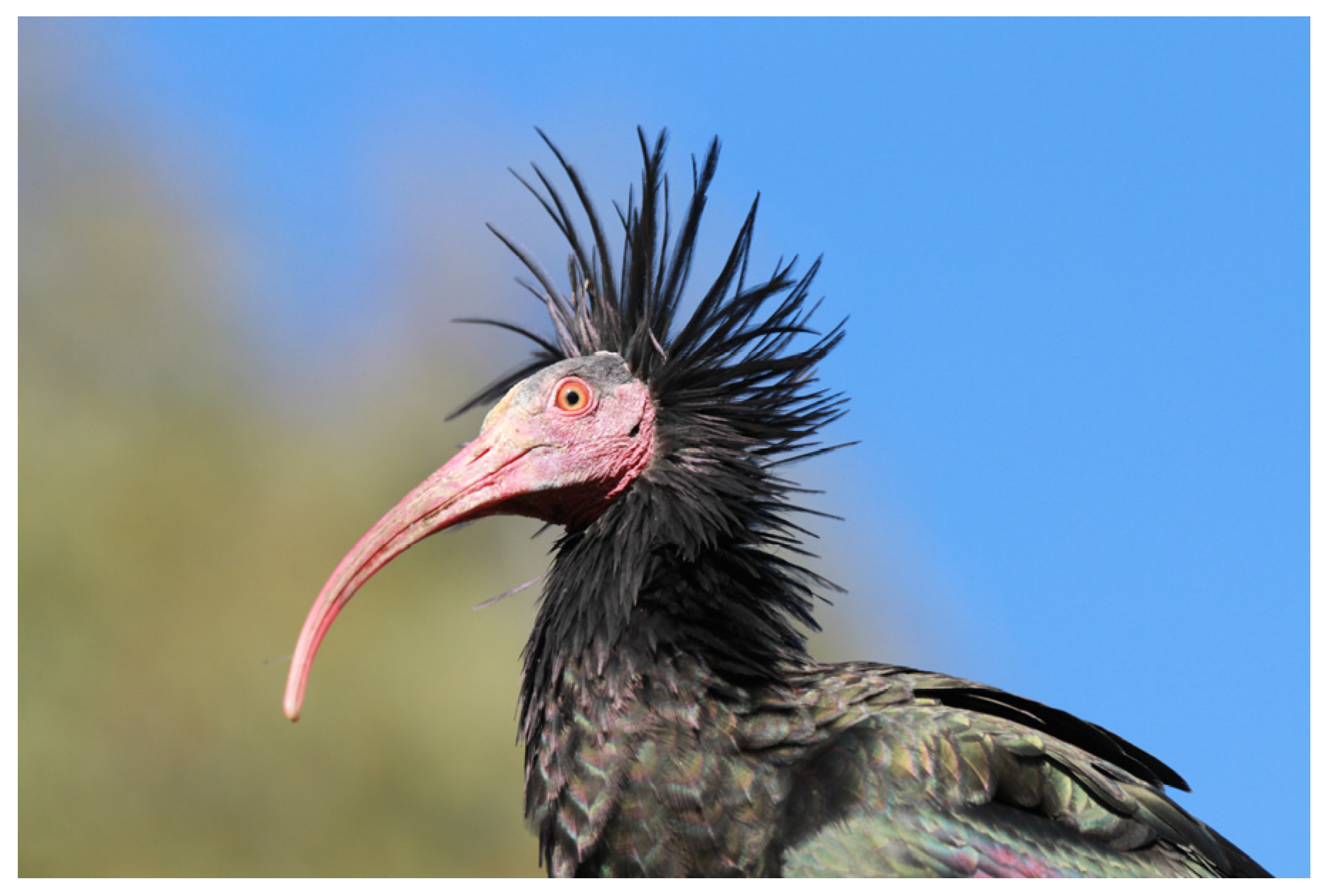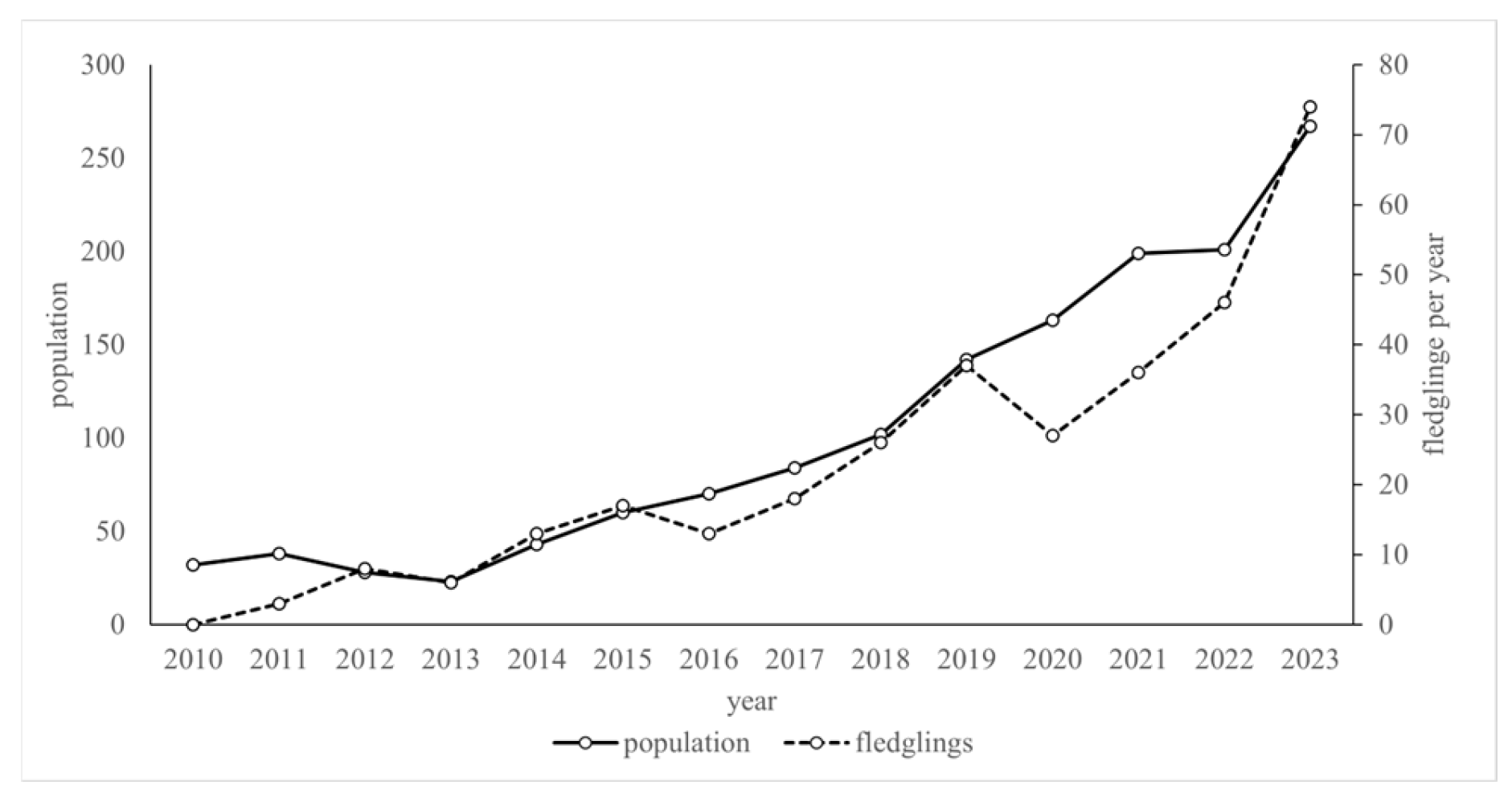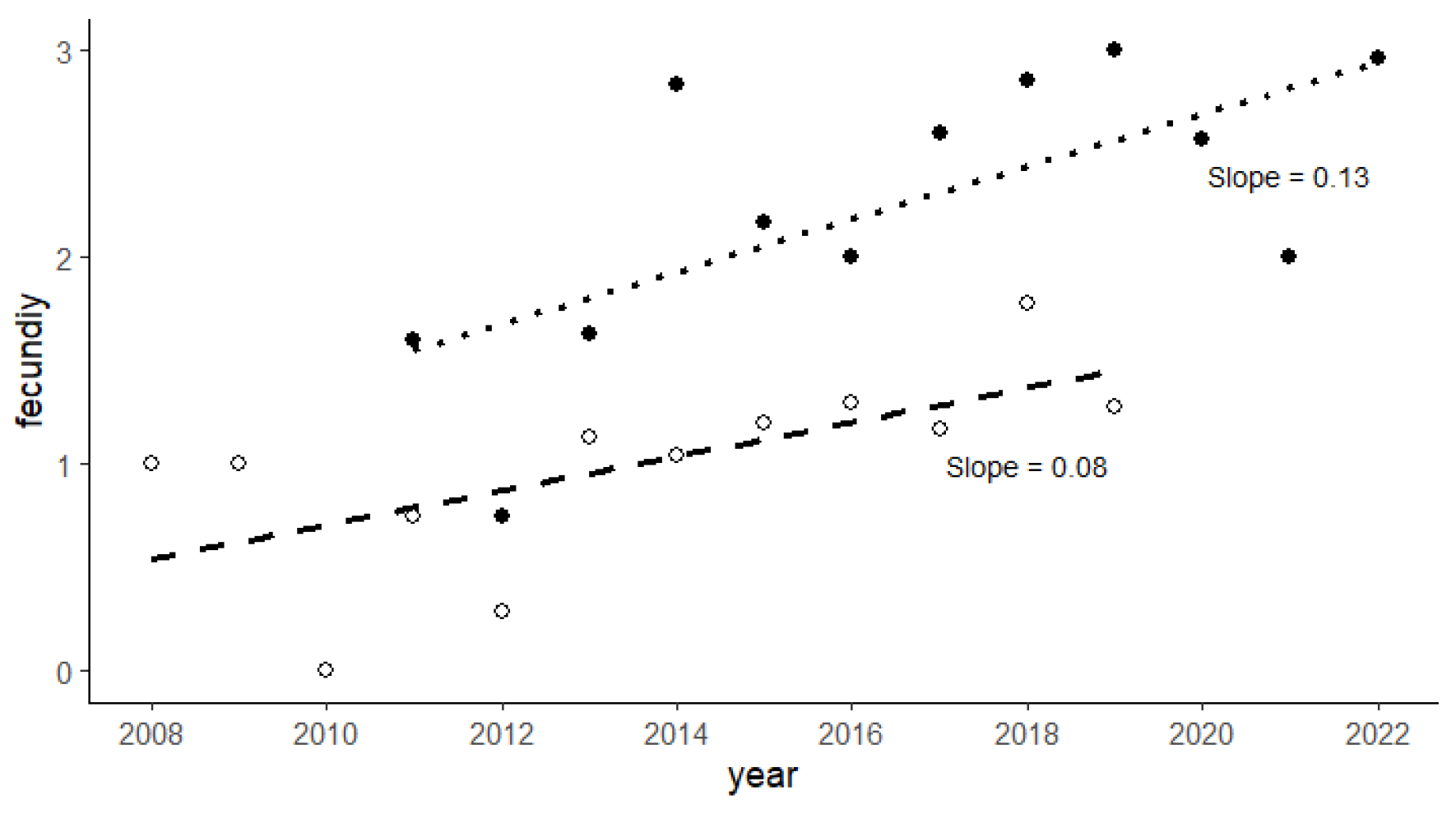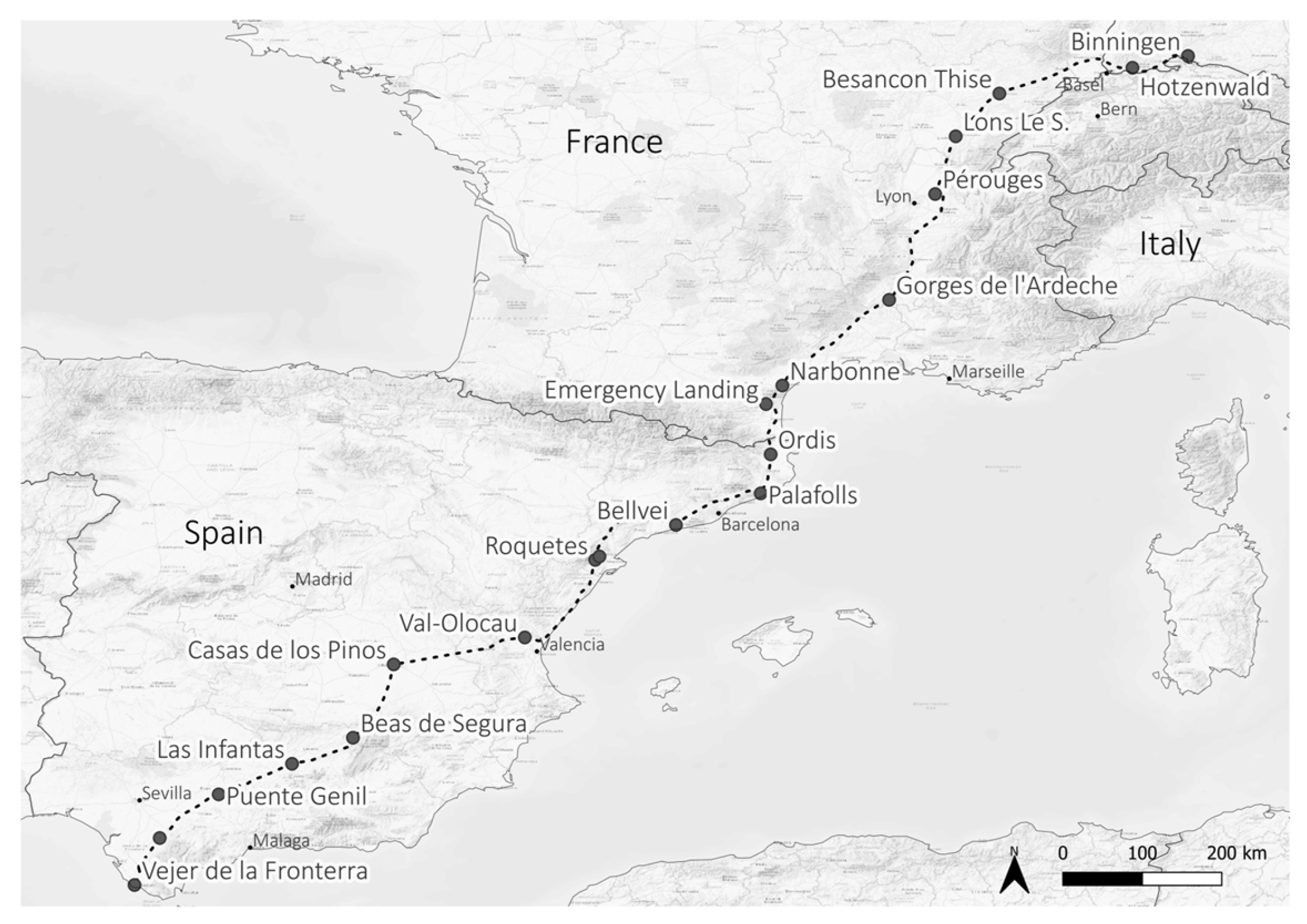Mitigating Acute Climate Change Threats to Reintroduced Migratory Northern Bald Ibises
Abstract
1. Introduction
2. Materials and Methods
3. Results
3.1. Reintroduction of a Migratory Population
3.2. Timing of the Autumn Migration and Immediate Emergency Measures
3.3. Initial Human-Led Migration to Andalusia
4. Discussion
4.1. The Northern Bald Ibis Reintroduction Project
4.2. Impact of Climate Change
4.3. Mitigation Measures Against the Effect of Climate Change
4.4. The Human-Led Migration Method
4.5. Perspectives
Author Contributions
Funding
Data Availability Statement
Conflicts of Interest
References
- Moehrenschlager, A. Can Conservation Translocation Turn Desperation to Inspiration? IUCN Blog: Gland, Switzerland, 2021. [Google Scholar]
- Armstrong, D.P.; Seddon, P.J. Directions in reintroduction biology. Trends Ecol. Evol. 2008, 23, 20–25. [Google Scholar] [CrossRef] [PubMed]
- Habibullah, M.S.; Din, B.H.; Tan, S.H.; Zahid, H. Impact of climate change on biodiversity loss: Global evidence. Environ. Sci. Pollut. Res. 2022, 29, 1073–1086. [Google Scholar] [CrossRef] [PubMed]
- Soorae, P.S. Global Conservation Translocation Perspectives: 2021; IUCN: Gland, Switzerland, 2021. [Google Scholar]
- Schenker, A.; Serra, G. Review of historical breeding sites of the Northern Bald Ibis Geronticus eremita in Syria and south-eastern Turkey. Bird Conserv. Int. 2022, 32, 137–146. [Google Scholar] [CrossRef]
- Bowden, C.G.R.; Smith, K.W.; El Bekkay, M.; Oubrou, W.; Aghnaj, A.; Jimenez-Armesto, M. Contribution of research to conservation action for the Northern Bald Ibis Geronticus eremita in Morocco. Bird Conserv. Int. 2008, 18, 74–90. [Google Scholar] [CrossRef]
- Lindsell, J.A.; Serra, G.; Peške, L.; Abdullah, M.S.; Al Qaim, G.; Kanani, A.; Wondafrash, M. Satellite tracking reveals the migration route and wintering area of the Middle East population of Critically Endangered northern bald ibis Geronticus eremita. Oryx 2009, 43, 329–335. [Google Scholar] [CrossRef]
- Unsoeld, M.; Fritz, J. Der Waldrapp-ein Vogel zwischen Ausrottung und Wiederkehr. Wildbiologie 2011, 2, 1–16. [Google Scholar]
- Schenker, A. Das ehemalige Verbreitungsgebiet des Waldrapps Geronticus eremita in Europa. Der Ornithol. Beob. 1977, 74, 13–30. [Google Scholar]
- Fritz, J.; Janák, J. Tracing the Fate of the Northern Bald Ibis over Five Millennia: An Interdisciplinary Approach to the Extinction and Recovery of an Iconic Bird Species. Animals 2022, 12, 1569. [Google Scholar] [CrossRef]
- Schenker, A.; Cahenzli, F.; Gutbrod, K.G.; Thevenot, M.; Erhard, A. The Northern Bald Ibis Geronticus eremita in Morocco since 1900: Analysis of ecological requirements. Bird Conserv. Int. 2020, 30, 117–138. [Google Scholar] [CrossRef]
- Akçakaya, H.R. Bald Ibis Geronticus eremita population in Turkey: An evaluation of the captive breeding project for reintroduction. Biol. Conserv. 1990, 51, 225–237. [Google Scholar] [CrossRef]
- Yenïyurt, C.; Oppel, S.; İsfendïyaroğlu, S.; Özkinaci, G.; Erkol, I.L.; Bowden, C.G.R. Influence of feeding ecology on breeding success of a semi-wild population of the critically endangered Northern Bald Ibis Geronticus eremita in southern Turkey. Bird Conserv. Int. 2016, 27, 537–549. [Google Scholar] [CrossRef]
- Böhm, C.; Bowden, C.G.; Seddon, P.J.; Hatipoğlu, T.; Oubrou, W.; El Bekkay, M.; Quevedo, M.A.; Fritz, J.; Yeniyurt, C.; Lopez, J.M.; et al. The northern bald ibis Geronticus eremita: History, current status and future perspectives. Oryx 2021, 55, 934–946. [Google Scholar] [CrossRef]
- Gross, M. Can zoos offer more than entertainment? Curr. Biol. 2015, 25, R391–R394. [Google Scholar] [CrossRef][Green Version]
- Wirtz, S.; Boehm, C.; Fritz, J.; Kotrschal, K.; Veith, M.; Hochkirch, A. Optimizing the genetic management of reintroduction projects: Genetic population structure of the captive Northern Bald Ibis population Sarah Wirtz. Conserv. Genet. 2018, 19, 853–864. [Google Scholar] [CrossRef]
- Fritz, J.; Feurle, A.; Kotrschal, K. Corticosterone pattern in Northern Bald Ibises during a human-led migration. J. Ornithol. 2006, 147, 168. [Google Scholar]
- Wehner, H.; Fritz, J.; Voelkl, B. Soaring and intermittent flap-gliding during migratory flights of Northern Bald Ibis. J. Ornithol. 2022, 163, 671–681. [Google Scholar] [CrossRef]
- Sperger, C.; Heller, A.; Voelkl, B.; Fritz, J. Flight Strategies of Migrating Northern Bald Ibises—Analysis of GPS Data During Human-led Migration Flights. AGIT J. Für Angew. Geo Inform. 2017, 3, 62–72. [Google Scholar]
- Portugal, S.J.; Hubel, T.Y.; Fritz, J.; Heese, S.; Trobe, D.; Voelkl, B.; Hailes, S.; Wilson, A.M.; Usherwood, J.R. Upwash exploitation and downwash avoidance by flap phasing in ibis formation flight. Nature 2014, 505, 399–402. [Google Scholar] [CrossRef]
- Perinot, E.; Fritz, J.; Fusani, L.; Voelkl, B.; Nobile, M.S. Characterization of bird formations using fuzzy modelling. J. R. Soc. Interface 2023, 20, 20220798. [Google Scholar] [CrossRef]
- Mizrahy-Rewald, O.; Perinot, E.; Fritz, J.; Vyssotski, A.L.; Fusani, L.; Voelkl, B.; Ruf, T. Empirical Evidence for Energy Efficiency Using Intermittent Gliding Flight in Northern Bald Ibises. Front. Ecol. Evol. 2022, 10, 891079. [Google Scholar] [CrossRef]
- IUCN/SSC. Guidelines for Reintroductions and Other Conservation Translocations; Version 1.0; IUCN Species Survival Commission: Gland, Switzerland, 2013. [Google Scholar]
- Ellis, D.H.; Sladen, W.J.; Lishman, W.A.; Clegg, K.R.; Duff, J.W.; Gee, G.F.; Lewis, J.C. Motorized Migrations: The Future or Mere Fantasy? Bioscience 2003, 53, 260. [Google Scholar] [CrossRef]
- Fritz, J.; Kramer, R.; Hoffmann, W.; Trobe, D.; Unsöld, M. Back into the wild: Establishing a migratory Northern bald ibis Geronticus eremita population in Europe. Int. Zoo Yearb. 2017, 51, 107–123. [Google Scholar] [CrossRef]
- Fritz, J.; Unsöld, M.; Völkl, B. Back into European Wildlife: The reintroduction of the northern bald ibis (Geronticus eremita). In Scientific Foundations of Zoos and Aquariums: Their Role in Conservation and Research, 1st ed.; Kaufman, A.B., Bashaw, M.J., Maple, T.L., Eds.; Cambridge University Press: Cambridge, UK, 2019; pp. 339–366. [Google Scholar]
- Hartup, B.K.; Olsen, G.H.; Czekala, N.M. Fecal corticoid monitoring in whooping cranes (Grus americana) undergoing reintroduction. Zoo Biol. 2005, 24, 15–28. [Google Scholar] [CrossRef]
- Eikenaar, C.; Müller, F.; Rüppel, G.; Stöwe, M. Endocrine regulation of migratory departure from stopover: Evidence from a longitudinal migratory restlessness study on northern wheatears. Horm. Behav. 2018, 99, 9–13. [Google Scholar] [CrossRef]
- Serra, G.; Abdallah, M.S.; Al Qaim, G. Feeding ecology and behaviour of the last known survivi8ng Northern Bald Ibises, Gerontius eremita, at theier breeing quarter in Syria. Zool. Middle East. 2008, 43, 55–68. [Google Scholar] [CrossRef]
- Wehner, H.; Huchler, K.; Fritz, J. Quantification of Foraging Areas for the Northern Bald Ibis (Geronticus eremita) in the Northern Alpine Foothills: A Random Forest Model Fitted with Optical and Actively Sensed Earth Observation Data. Remote Sens. 2022, 14, 1015. [Google Scholar] [CrossRef]
- Fritz, J.; Eberhard, B.; Esterer, C.; Goenner, B.; Trobe, D.; Unsoeld, M.; Voelkl, B.; Wehner, H.; Scope, A. Biologging is suspect to cause corneal opacity in two populations of wild living Northern Bald Ibises (Geronticus eremita). Avian Res. 2020, 11, 38. [Google Scholar] [CrossRef]
- Mizrahy-Rewald, O.; Winkler, N.; Amann, F.; Neugebauer, K.; Voelkl, B.; Grogger, H.A.; Ruf, T.; Fritz, J. The impact of shape and attachment position of biologging devices in Northern Bald Ibises. Anim. Bio Telem. 2023, 11, 8. [Google Scholar] [CrossRef]
- Stanclova, G.; Schwendenwein, I.; Merkel, O.; Kenner, L.; Dittami, J.; Fritz, J.; Scope, A. The effect of migratory flight on hematologic parameters in northern bald ibises (Geronticus eremita). J. Zoo Wildl. Med. 2017, 48, 1154–1164. [Google Scholar] [CrossRef]
- Bairlein, F.; Fritz, J.; Scope, A.; Schwendenwein, I.; Stanclova, G.; Van Dijk, G.; Meijer, H.A.J.; Verhulst, S.; Dittami, J. Energy expenditure and metabolic changes of free-flying migrating northern bald ibis. PLoS ONE 2015, 10, e0134433. [Google Scholar] [CrossRef]
- Voelkl, B.; Portugal, S.J.; Unsöld, M.; Usherwood, J.R.; Wilson, A.M.; Fritz, J. Matching times of leading and following suggest cooperation through direct reciprocity during V-formation flight in ibis. Proc. Natl. Acad. Sci. USA 2015, 112, 2115–2120. [Google Scholar] [CrossRef] [PubMed]
- Drenske, S.; Radchuk, V.; Scherer, C.; Esterer, C.; Kowarik, I.; Fritz, J.; Kramer-Schadt, S. On the road to self-sustainability: Reintroduced migratory European northern bald ibises Geronticus eremita still need management interventions for population viability. Oryx 2023, 57, 637–648. [Google Scholar] [CrossRef]
- Gordo, O. Why are bird migration dates shifting? A review of weather and climate effects on avian migratory phenology. Clim. Res. 2007, 35, 37–58. [Google Scholar] [CrossRef]
- Visser, M.E.; Perdeck, A.C.; van Balen, J.H.; Both, C. Climate change leads to decreasing bird migration distances. Glob. Chang. Biol. 2009, 15, 1859–1865. [Google Scholar] [CrossRef]
- Zaifman, J.; Shan, D.; Ay, A.; Jimenez, A.G. Shifts in Bird Migration Timing in North American Long-Distance and Short-Distance Migrants Are Associated with Climate Change. Int. J. Zool. 2017, 2017, 6025646. [Google Scholar] [CrossRef]
- Pinszke, A.; Remisiewicz, M. Long-term changes in autumn migration timing of Garden Warblers Sylvia borin at the southern Baltic coast in response to spring, summer and autumn temperatures. Eur. Zool. J. 2023, 90, 283–295. [Google Scholar] [CrossRef]
- Schilling, J.; Freier, K.P.; Hertig, E.; Scheffran, J. Climate change, vulnerability and adaptation in North Africa with focus on Morocco. Agric. Ecosyst. Environ. 2012, 156, 12–26. [Google Scholar] [CrossRef]
- Radchuk, V.; Reed, T.; Teplitsky, C.; van de Pol, M.; Charmantier, A.; Hassall, C.; Adamík, P.; Adriaensen, F.; Ahola, M.P.; Arcese, P.; et al. Adaptive responses of animals to climate change are most likely insufficient. Nat. Commun. 2019, 10, 3109. [Google Scholar] [CrossRef]
- Møller, A.P.; Rubolini, D.; Lehikoinen, E. Populations of migratory bird species that did not show a phenological response to climate change are declining. Proc. Natl. Acad. Sci. USA 2008, 105, 16195–16200. [Google Scholar] [CrossRef]
- Halupka, L.; Arlt, D.; Tolvanen, J.; Millon, A.; Bize, P.; Adamík, P.; Albert, P.; Arendt, W.J.; Artemyev, A.V.; Baglione, V.; et al. The effect of climate change on avian offspring production: A global meta-analysis. Proc. Natl. Acad. Sci. USA 2023, 120, e2208389120. [Google Scholar] [CrossRef]
- Bowden, C.G.R.; Orueta, J.F.; Vázquez, J.M.L.; Onrubia, A.; Quevedo, M.A. Sightings of reintroduced northern bald ibis Geronticus eremita crossing between Spain and Morocco are probably hand-reared rather than wild-born. Oryx 2018, 52, 411–412. [Google Scholar] [CrossRef]
- Marco, A.S. The presence of the waldrapp Geronticus eremita (Plataleidae) in the plio-pleistocene boundary in Spain. Ibis 1996, 138, 560–561. [Google Scholar] [CrossRef]
- Finlayson, C.; Pacheco, F.G.; Rodríguez-Vidal, J.; Fa, D.A.; López, J.M.G.; Pérez, A.S.; Finlayson, G.; Allue, E.; Preysler, J.B.; Cáceres, I.; et al. Late survival of Neanderthals at the southernmost extreme of Europe. Nature 2006, 443, 850–853. [Google Scholar] [CrossRef] [PubMed]
- Schenker, A.; Litwan, P.; Roland, M.; Wien, A. Belege für ein Brutvorkommen des Waldrapps Geronticus eremita in Westfrankreich aus dem 14. Jahrhundert. Vogelwarte 2024, 62, 167–174. [Google Scholar]
- Piersma, T.; de Goeij, P.; Bouten, W.; Zuhorn, C. Sinagote: The Biography of a Spoonbill; Lynx Edicions: Cerdanyola del Vallès, Spain, 2022. [Google Scholar]
- Teitelbaum, C.S.; Converse, S.J.; Fagan, W.F.; Böhning-Gaese, K.; O’hara, R.B.; Lacy, A.E.; Mueller, T. Experience drives innovation of new migration patterns of whooping cranes in response to global change. Nat. Commun. 2016, 7, 12793. [Google Scholar] [CrossRef]
- Fritz, J. On the experimental introduction of migratory Northern Bald Ibis colonies. In Proceedings of the International Advisory Group for the Northern Bald Ibis (IAGNBI) Meeting, Palmyra, Syria, 1 November 2009. [Google Scholar]
- Fritz, J. The Scharnstein Project: Establishing a migratory Waldrapp colony by introducing a new migration route with ultra-light planes. In Proceesings of the IAGNBI Meeting; Bowden, C., Böhm, C., Eds.; Royal Society for the Protection of Birds: Sandy, UK, 2003. [Google Scholar]
- Unsoeld, M.; Fritz, J. Artenschutzprojekt Waldrappteam: Potenzial und Risiken von Prägung als Methode für den Artenschutz. Vogelwarte 2016, 54, 365–366. [Google Scholar]
- Fritz, J. Energieoptimierung und Strukturierung des Migrationsfluges: Der V-Formationsflug bei Waldrappen. Vogelwarte 2014, 52, 316–317. [Google Scholar]
- Fritz, J. Waldrapp Migration 2004: Beobachtungen zum Orientierungs- und Navigationsvermögen der Waldappe Geronticus eremita. Monticual 2005, 96, 249–259. [Google Scholar]
- Voelkl, B.; Fritz, J. Relation between travel strategy and social organization of migrating birds with special consideration of formation flight in the northern bald ibis. Philos. Trans. R. Soc. B Biol. Sci. 2017, 372, 20160235. [Google Scholar] [CrossRef]
- Kotrschal, K. The Grünau Project: Establishing a semi-wild colony of Waldrapp Ibis. WAZA Mag. 2004, 5, 12–15. [Google Scholar]







Disclaimer/Publisher’s Note: The statements, opinions and data contained in all publications are solely those of the individual author(s) and contributor(s) and not of MDPI and/or the editor(s). MDPI and/or the editor(s) disclaim responsibility for any injury to people or property resulting from any ideas, methods, instructions or products referred to in the content. |
© 2024 by the authors. Licensee MDPI, Basel, Switzerland. This article is an open access article distributed under the terms and conditions of the Creative Commons Attribution (CC BY) license (https://creativecommons.org/licenses/by/4.0/).
Share and Cite
Fritz, J.; Unsoeld, M.; Goenner, B.; Kramer, R.; Siebert-Lang, L.; Wehner, H. Mitigating Acute Climate Change Threats to Reintroduced Migratory Northern Bald Ibises. Conservation 2024, 4, 748-761. https://doi.org/10.3390/conservation4040044
Fritz J, Unsoeld M, Goenner B, Kramer R, Siebert-Lang L, Wehner H. Mitigating Acute Climate Change Threats to Reintroduced Migratory Northern Bald Ibises. Conservation. 2024; 4(4):748-761. https://doi.org/10.3390/conservation4040044
Chicago/Turabian StyleFritz, Johannes, Markus Unsoeld, Bernhard Goenner, Regina Kramer, Lisbet Siebert-Lang, and Helena Wehner. 2024. "Mitigating Acute Climate Change Threats to Reintroduced Migratory Northern Bald Ibises" Conservation 4, no. 4: 748-761. https://doi.org/10.3390/conservation4040044
APA StyleFritz, J., Unsoeld, M., Goenner, B., Kramer, R., Siebert-Lang, L., & Wehner, H. (2024). Mitigating Acute Climate Change Threats to Reintroduced Migratory Northern Bald Ibises. Conservation, 4(4), 748-761. https://doi.org/10.3390/conservation4040044








